 |
Home | Charity | Feedback |
Thailand:
Bangkok,
Chiang Mai,
Erawan National Park
Kanchanaburi,
Tiger Temple
Chiang Mai, Thailand: Cultural and religious centre by Prakash Bang, Editor in Chief 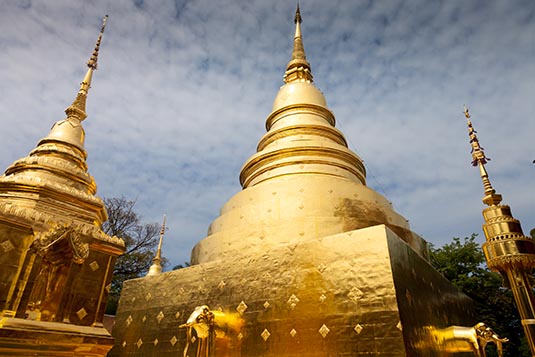 Chiang Mai is a city in mountainous northern Thailand. Founded in 1296, it was capital of the independent Lanna Kingdom until 1558. Its Old City area still retains vestiges of walls and moats from its history as a cultural and religious center. It’s also home to hundreds of elaborate Buddhist temples. 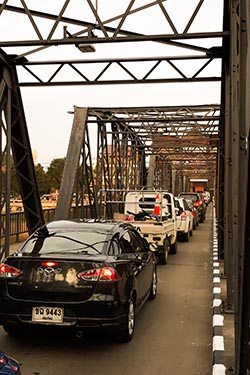 Chiang Mai was our last leg of our tour that took us through Cambodia, Vietnam and Laos. We arrived late afternoon from Luang Prabang. We would be there for 2 nights and were booked at the beautiful Shangri-La Hotel, walking distance from the night market and the river.
Chiang Mai was our last leg of our tour that took us through Cambodia, Vietnam and Laos. We arrived late afternoon from Luang Prabang. We would be there for 2 nights and were booked at the beautiful Shangri-La Hotel, walking distance from the night market and the river.
On the evening of the arrival we explored the city's famous night market. A long street with lanes full of small shops selling things of sorts; not to forget the food vendors. Life in the market starts late evening and ends up early in the morning. Of course, we were back in our comfortable hotel room by midnight. Since we only had a day and a half on hand, we would spend the next day exploring Chiang Mai's famous temples and the Old Town. Post breakfast we hired a taxi that would take us to Wat Phra That Doi Suthep, one of the most revered temples situated on a hill about an hour's drive from our hotel. The taxi would bring us back and drop us at the gates of the Old Town. Thereafter the plan was to move around on foot and in a Tuk Tuk. 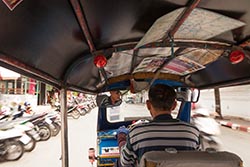 Construction on Wat Doi Suthep began in 1386 under King Kuena and was completed within a few years. The temple complex was periodically expanded and embellished over the following centuries. Construction would have been an arduous task, with workers having to carry supplies through thick jungle: the road leading to the temple was only installed in 1935.
Construction on Wat Doi Suthep began in 1386 under King Kuena and was completed within a few years. The temple complex was periodically expanded and embellished over the following centuries. Construction would have been an arduous task, with workers having to carry supplies through thick jungle: the road leading to the temple was only installed in 1935.
According to legend, a magical relic multiplied itself just before it was enshrined at Wat Suan Dok in Chiang Mai. A suitable place therefore had to be found to shelter the new relic. 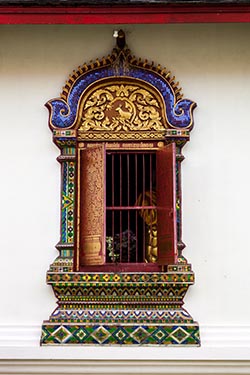 Unable to decide on the site, the king placed the relic in a portal shrine on the back of a white elephant and waited to see where the animal would take it. Eventually, the elephant walked up to the top of Doi Suthep Mountain, trumpeted three times, turned around three times, knelt down, and died. The temple was immediately built on the miraculously-chosen site.
Unable to decide on the site, the king placed the relic in a portal shrine on the back of a white elephant and waited to see where the animal would take it. Eventually, the elephant walked up to the top of Doi Suthep Mountain, trumpeted three times, turned around three times, knelt down, and died. The temple was immediately built on the miraculously-chosen site.
Wat Doi Suthep is approached by a steep flight of 300 stairs flanked by green trees and guarded by 16th-century Naga (snake) figures. An easier, if less atmospheric, route is via an adjacent funicular, which we opted for. Doi Suthep Mountain rises about 1000 metres above sea level; there are fine views over the city of Chiang Mai to be had from the temple's lower terrace. The terrace is surrounded by large bells that are rung by pilgrims to bring good luck. On the northwest corner of the terrace is a statue of the legendary elephant who chose the site of the temple. Enclosed by a frescoed cloister, the upper terrace is home to a tightly-packed complex of small shrines, bells, golden umbrellas and Buddha statues. 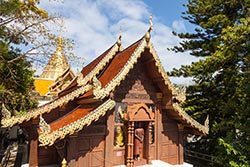 In the center of the upper terrace is the great chedi, a 16th-century expansion of the 14th-century original. After spending an hour at the dazzling gold-plated temple we took the funicular down and headed for Old Town.
In the center of the upper terrace is the great chedi, a 16th-century expansion of the 14th-century original. After spending an hour at the dazzling gold-plated temple we took the funicular down and headed for Old Town.
We were dropped at the gates of Wat Phra Singh. There are several magnificent and very old temples within the walled old city of Chiang Mai, with the Wat Phra Singh being one of the most attractive. The temple, which is also known as “The Monastery of the Lion Buddha” or “The temple of the Lion Buddha” is an active temple, with hundreds of monks and novices living there. The Wat Phra Singh houses a number of highly revered and very old Buddha images. 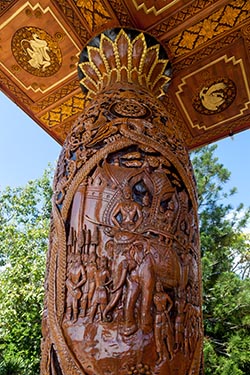 The Wat Phra Singh dates back to the 14th century when Chiang Mai was the capital of the Lanna Kingdom, and is one of the finest examples of classic Lanna style temple architecture in Northern Thailand.
The Wat Phra Singh dates back to the 14th century when Chiang Mai was the capital of the Lanna Kingdom, and is one of the finest examples of classic Lanna style temple architecture in Northern Thailand.
The oldest structure of the wat is the main chedi, that was built in 1345 by King Pha Yu to enshrine the ashes of his father. The chedi is circular in shape with a square base. Each of the sides of the chedi is decorated with elephant figures emerging from the chedi. Since its construction in the 14th century it has been enlarged considerably. The temple complex was originally named Wat Li Chiang Phra, until 1367 when the Phra Singh Buddha image was brought here and the name was changed to Wat Phra Singh, named after the image. The origin of the Phra Singh Buddha image is not known with certainty, according to local belief the image originates from Sri Lanka. From here, we hired a Tuk Tuk. Our next stop was Wat Chedi Luang. 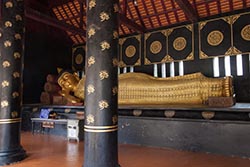 The Wat Chedi Luang, also known as the Jedi Luang and “The temple of the Great Stupa” initially consisted of two more temples named Wat Ho Tham and Wat Sukmin, that were all merged into one.
The Wat Chedi Luang, also known as the Jedi Luang and “The temple of the Great Stupa” initially consisted of two more temples named Wat Ho Tham and Wat Sukmin, that were all merged into one.
The Wat's most prominent feature is the massive and very impressive chedi (pagoda) dominating the area. The chedi was ordered by King Saen Muang Ma to enshrine the ashes of his father. Construction began in 1391 and lasted almost a century. When the chedi was finally finished in 1475 during the reign of King Tilokarat it had reached a height of about 85 meters and a width of 44 meters, which made it by far the largest structure of Chiang Mai. In the year 1545 disaster struck when a massive earthquake destroyed much of the chedi. In the 1990’s the chedi was partially restored. 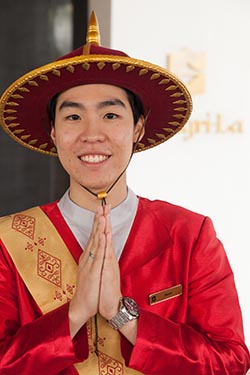 All four sides contain large staircases flanked by guardian mythical Naga creatures. At the top of the stairs are niches, where Buddha images are enshrined. Just below the top of the stairs is a platform containing Sinhalese style stone elephants on one side emerging from the chedi.
All four sides contain large staircases flanked by guardian mythical Naga creatures. At the top of the stairs are niches, where Buddha images are enshrined. Just below the top of the stairs is a platform containing Sinhalese style stone elephants on one side emerging from the chedi.
In 1468, the most important and revered Buddha image in Thailand, the emerald Buddha was installed in the Wat Chedi Luang. The image stayed here for almost a century, when it was moved to Luang Prabang, in current day Laos. Today, the image is housed in the Wat Phra Kaew in Bangkok. To commemorate the 600th anniversary of the chedi a reproduction of the emerald Buddha was placed in one of the niches of the chedi. The temple grounds contain two viharns. The first one is a large, impressive building with a three tiered roof and a front facade in golden colors. This viharn was built in 1928. The high red ceiling is supported by two rows of tall, round columns. This viharn contains a large standing Buddha image opposite the entrance, named Phra Chao Attarot. This image displaying the Abhaya mudra (the dispelling of fear hand gesture) dates back to the time when the Wat Chedi Luang was founded; it was cast towards the end of the 14th century. 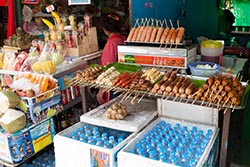 The other much smaller viharn has a very elegantly decorated front facade with intricate wood carvings. The stairs leading to the entrance are guarded by large Nagas, mythical snake like creatures. Next to it is a small pavilion in Burmese style.
The other much smaller viharn has a very elegantly decorated front facade with intricate wood carvings. The stairs leading to the entrance are guarded by large Nagas, mythical snake like creatures. Next to it is a small pavilion in Burmese style.
The Tuk Tuk then took us to Wat Chiang Man - the oldest temple in Chiang Mai and goes back all the way to the founding of the city in 1296. When King Mengrai decided to build a new city and make it the new capital of the Lanna Kingdom, he build the Wat Chiang Man as the first temple of the new city on the site he used to supervise the construction of Chiang Mai. The temple holds several very old and important Buddha images. 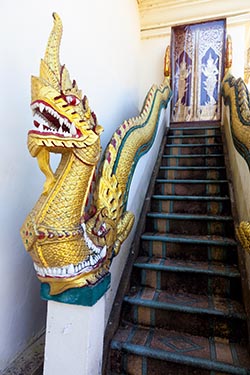 Like in most wats, the oldest structure is the chedi. The chedi named Chang Lom Chedi or Elephant Chedi sits on a square base supporting a second level of grey stone that is surrounded by 15 elephants that seem to emerge from it. On top sits the gilded upper part of the chedi, which contains a relic chamber. The chedi is a mixture of Lanna and Singhalese styles.
Like in most wats, the oldest structure is the chedi. The chedi named Chang Lom Chedi or Elephant Chedi sits on a square base supporting a second level of grey stone that is surrounded by 15 elephants that seem to emerge from it. On top sits the gilded upper part of the chedi, which contains a relic chamber. The chedi is a mixture of Lanna and Singhalese styles.
The larger of the two viharns is an impressive building with a three tiered roof. The front of the Lanna style viharn is decorated with wood carvings in gold and ochre colors. The building was renovated in the 1920’s by the famous monk Khru Ba Srivichai. This viharn houses the oldest Buddha image in Chiang Mai. The image is a standing Buddha holding an alms bowl, the inscription on its base dates it to 1465. The smaller of the viharns which is also built in Lanna style contains two small, but very old and important Buddha images. The stairs to the viharns entrance are guarded by Nagas, a mythical snake like creature. 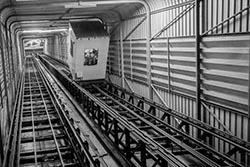 It was late afternoon and time to head back to our hotel. The Tuk Tuk did its job.
It was late afternoon and time to head back to our hotel. The Tuk Tuk did its job.
That evening we walked to the river. Being a full-moon night, a lantern festival was on. Paper lanterns were all around and locals were engrossed in placing their oil lamps on the river. Our flight back home was in the afternoon. We remained at our hotel and enjoyed its beautiful spa. We deserved the treat... it was 15 days of travel. Chiang Mai Image Gallery  Photo viewer Photo viewer
|
|
|
Home |
Charity |
Feedback
Privacy Policy | Terms of Usage © YoGoYo.com. All rights reserved. |



























































